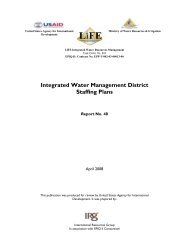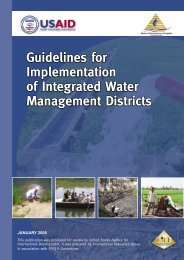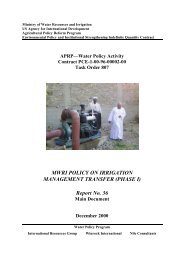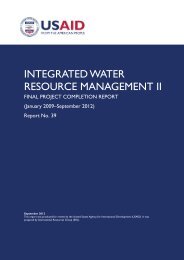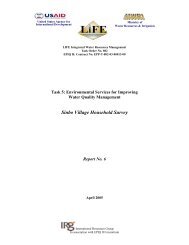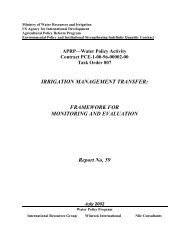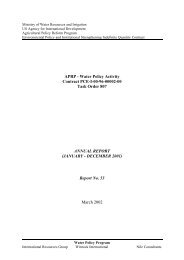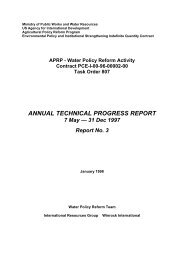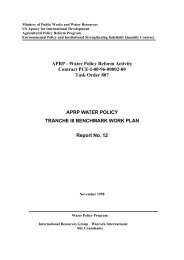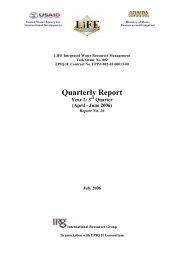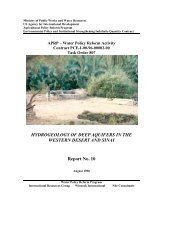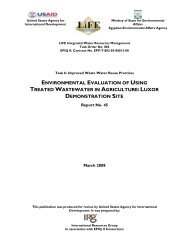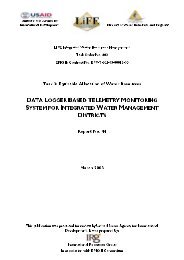Report 26 Annual Work Plan Workshop - LIFE-IWRMII Project, Egypt
Report 26 Annual Work Plan Workshop - LIFE-IWRMII Project, Egypt
Report 26 Annual Work Plan Workshop - LIFE-IWRMII Project, Egypt
You also want an ePaper? Increase the reach of your titles
YUMPU automatically turns print PDFs into web optimized ePapers that Google loves.
INTEGRATED WATER<br />
RESOURCE MANAGEMENT II<br />
ANNUAL WORKPLAN WORKSHOP REPORT<br />
YEAR 4<br />
REPORT NO. <strong>26</strong><br />
December 2011<br />
This report is made possible by the support of the American People through the United States Agency for International<br />
Development (USAID). It was prepared by International Resources Group (IRG).<br />
TITLE 1
INTEGRATED WATER<br />
RESOURCE MANAGEMENT II<br />
ANNUAL WORK PLAN WORKSHOP REPORT –YEAR 4<br />
November 16 -18, 2011<br />
Ain Sukhna Movenpick Resort<br />
<strong>Report</strong> No. <strong>26</strong><br />
Contract No. EPP-I-00-04-00024-00 Task Order No. 06<br />
December 2011<br />
DISCLAIMER<br />
The author’s views expressed in this publication do not necessarily reflect the views of the United States<br />
Agency for International Development or the United States Government.<br />
ANNUAL WORKPLAN WORKSHOP REPORT – YEAR 4 1
TABLE OF CONTENTS<br />
1. EXECUTIVE SUMMARY ······································································ 1<br />
II. WORKSHOP REPORT ········································································ 6<br />
1. Introduction ..................................................................................................................................................... 6<br />
2. <strong>Work</strong>shop Goals ............................................................................................................................................ 7<br />
3. Participants ...................................................................................................................................................... 7<br />
4. <strong>Work</strong>shop Proceedings/Sessions ............................................................................................................... 7<br />
III. OBSERVATIONS/ COMMENTS ·························································· 14<br />
IV. CONCLUSIONS & RECOMMENDATIONS ··········································· 15<br />
ANNEX 1 ·································································································· 18<br />
ANNUAL WORKPLAN WORKSHOP REPORT – YEAR 4 1
1. EXECUTIVE SUMMARY<br />
<strong>Work</strong>shop Goals<br />
<strong>Work</strong>shop goals, defined by the project's management as the basis for workshop activities, are as<br />
follows:<br />
1. Introduce IWRM II present situation after the elapse of three years since its inception.<br />
2. Present year-4 work plan and come to an agreement on activities roles, responsibilities and<br />
resources required to realize project objectives.<br />
3. Discuss future vision for cooperation between MWRI and USAID.<br />
<strong>Work</strong>shop Design & Set-up:<br />
The workshop has been organized by <strong>IWRMII</strong> under the auspices of H. E. Prof. Dr. Hesham<br />
Kandil, Minister of Water Resources and Irrigation. It was attended by the <strong>Project</strong>'s Steering<br />
Committee members, MWRI's concerned top management officials, USAID representations, Under-<br />
Secretaries, General Directors and IWRM staff from districts within the project's area of assignment.<br />
The project's team members were also present.<br />
The workshop was held from Nov., 16th to Nov., 18th 2011 at Movenpick Hotel, Ain Sukhna.<br />
During the workshop, presentations covering the various project tasks were made in two parts; 1)<br />
Achievements presented by project staff; and 2) Actual implementation experience presented by<br />
MWRI IWMD staff. The following lists all the presentations given at the workshop:<br />
• <strong>IWRMII</strong> project Overview.<br />
• Formation and Development of Branch Canal Water Users Associations (Achievements/<br />
Actual implementation- Deyarb Negm IWRM District).<br />
• Improvements in Water Productivity and Efficiency (Achievements/ Actual Implementation<br />
– West Belbais IWRM District).<br />
• Formation and Development of Integrated Water Management Districts (Achievements<br />
/Actual implementation, Al Mollak IWRM District, Salhia).<br />
• Establishment of Information Management Systems for Sustainable Water Resources<br />
Management (Achievements / Actual Implementation, East Buhyrat IWRM District,<br />
Ismailia).<br />
• Capacity Building of MWRI Personnel.<br />
• Competence- based Training.<br />
• Sustainability (IWRM I & IWRM II).<br />
• Year-4 work plan.<br />
• USAID Vision for the future, Human Capacity Development and Rehabilitation of<br />
Waterways.<br />
Ample time provided for discussion, observations, comments and exchange of ideas. This was<br />
conducive to arriving at conclusions and recommendations addressed to the competent departments<br />
ANNUAL WORKPLAN WORKSHOP REPORT – YEAR 4 1
and other stakeholders, with a view to achieve maximum efficiency and effectiveness from project<br />
objectives and outcomes.<br />
Observations/ Comments<br />
Participants were active throughout the workshop and made many, diverse comments that are<br />
summarized as follows:<br />
• <strong>Project</strong> achievements have had a concrete/positive impact on promoting the concept of<br />
integration in managing water resources, which is one of MWRI's policies.<br />
• Integration, Participation and Decentralization have been underscored as the pillars of<br />
IWRM.<br />
• Despite the prevailing situation in <strong>Egypt</strong>, the IWRMDs have been exerting unrelenting<br />
efforts in managing the country's water resources.<br />
• IWMDs are a first step towards integration.<br />
• IWMDs represent a paradigm shift in water resources management. They have achieved<br />
remarkable progress in their initial steps.<br />
• There are numerous benefits resulting from the application of IWRM.<br />
• Success of IWRM at district level is tantamount to the attainment of MWRI objectives.<br />
• There exists a clear difference in the overall performance of integrated districts and that of<br />
the traditional (irrigation) districts which have not been developed as integrated districts so<br />
far.<br />
• Human capital development is a key factor and competence must be the basis for selection<br />
to leadership positions. Proven leaders should continue to serve in their positions (i.e.<br />
minimal turnover: the translator).<br />
• It is quite imperative to improve performance in applying IWRM and maintaining the<br />
success achieved so far.<br />
• IWMDs must be supported to help them solve the many problems encountered at district<br />
level; thus enhancing decentralization.<br />
• Actively involving Water Users Organizations (WUOs) in managing water Resources is<br />
important.<br />
• The vision at the Central/ National level must be clearer than that at district level. Therefore,<br />
IWMDs must be properly coached to ensure full utilization of the water system.<br />
Recommendations<br />
1. YEAR-4 <strong>Work</strong> <strong>Plan</strong><br />
• Approval of year-4 work plan of <strong>IWRMII</strong>.<br />
2. Integrated Water Management Districts (IWMDs)<br />
• Upgrade IWMDs (of phase -1) and train their new staff in integrated water management.<br />
• Strongly focus on qualification of WATs at IWMDs (being the backbone far promoting<br />
participation).<br />
2 ANNUAL WORKPLAN WORKSHOP REPORT – YEAR 4
• Add to the databases such data and information on reuse of treated agricultural drainage and<br />
wastewater.<br />
• Regulate modes of provisioning the required resources for the IWMDs (e.g. equipment)<br />
[Sustainability plan].<br />
• Continue to provide technical and institutional support; and assist in building the technical<br />
capabilities of both district and directorate – level personnel, Also keep trained cadres in<br />
place as long as possible (i.e. low turnover; translator).<br />
• Encourage promotion to higher position of IWMD's personnel, on condition that they are<br />
replaced by efficient staff members.<br />
• Carefully select IWMD directors to ensure that integration proceeds in the right direction<br />
(based on belief in the principles of decentralization, user participation and building a second<br />
line of leadership).<br />
3. Branch Canal Water Users Association (BCWUAs)<br />
• Despite the existing tribulations through which the country goes, it is imperative to<br />
promulgate the WUA legislation to empower them to undertake their roles in managing<br />
water resources.<br />
• Designate an entity (within MWRI) responsible for evaluating performance of WUAs at both<br />
district and general directorate levels.<br />
• Consider the issue of securing offices for BCWUAs (sustainability plan).<br />
• Promote and support exchange of visits among WUAs; and keep-up with their training by<br />
WAT at district level (sustainability plan).<br />
4. Irrigation and Drainage Integration within IWMDs<br />
• Complete the process of integrating the irrigation and drainage functions within IWMD,<br />
General Directorate and higher levels.<br />
• Attach the responsibility for maintenance of main drains to the IWMD or General<br />
Directorate.<br />
5. Training and Communication<br />
• Design and implement a training program in integrated water management for general<br />
directors and inspectors at those directorates where the project has not been implemented.<br />
• Organize awareness courses for directors and engineers of the directorates where Life<br />
<strong>Project</strong> was not implemented, with a view to predispose them to future transformation to<br />
ibntegration.<br />
• Train irrigation, drainage and ground water engineers in integrated water management<br />
(irrigation, drainage and ground water, mechanical and electricity services …. etc).<br />
• Consider the potential for introducing Farmer-to-Farmer schools.<br />
• Develop training programs to suit present and future requirements.<br />
• Employ all media tools intensively to highlight the significance and positive impact of user<br />
involvement in managing water resources.<br />
ANNUAL WORKPLAN WORKSHOP REPORT – YEAR 4 3
6. Matching Irrigation Water Supply and Demand (MISD)<br />
• Train basin supervisors and WUA members in crop data collection, including crop acreage,<br />
to activate MISD program.<br />
• Apply the cooperation and coordination protocol between MWRI and MALR concerning<br />
the matching program.<br />
7. Alternative High Value Crops<br />
• Upscale the pilot to the other IWMDs.<br />
8. Sustainability<br />
• Prepare a plan for sustainability after the end of project life (tasks, roles and responsibilities,<br />
requirements). The plan must cover IWRM I and IWRM II. It should identify a mechanism<br />
to ensure sustainability, considering both water scarcity and lack of financial resources.<br />
• An entity within MWRI must be entrusted with IWRM and with formation and development<br />
of IWMDs, including M&E to ensure their proper functioning and to coordinate IWRM<br />
activities within MWRI.<br />
• Clearly define roles and responsibilities of all partners at all levels.<br />
• Seek to unify IWRM messages (joint training of all the stakeholders in IWRM).<br />
• Draw-up a system for the flow of information among the concerned parties.<br />
• Prepare a check-list for the evaluation of IWMDS, taking into account the command area,<br />
number of WUAs and success stories.<br />
• Specify the position of water advisory service unit within the IWMD's organizational<br />
structure, number of staff working therein and interrelationships with the various water<br />
advisory service entities within MWRI.<br />
• Emphasize the principle of decentralization among all MWRI's top management levels, with<br />
a view to accelerate implementation of integration and participation concepts.<br />
• Based on the very same concept of participation, see to it that the other concerned ministries<br />
(Agriculture, EEAA and Housing) are strongly involved in IWRM at IWMDs.<br />
9. The <strong>Project</strong> (IWRM II)<br />
• Consider the possibility for the project to create water boards at IWMDs within the project<br />
region.<br />
• Provide full support to project activities by all MWRI sectors in this final year.<br />
4 ANNUAL WORKPLAN WORKSHOP REPORT – YEAR 4
Main <strong>Work</strong>shop <strong>Report</strong><br />
ANNUAL WORKPLAN WORKSHOP REPORT – YEAR 4 5
II. WORKSHOP REPORT<br />
1. Introduction<br />
Through cooperation between MWRI and USAID, IRG is implementing the Integrated Water<br />
Resource Management <strong>Project</strong> (IWRM) (phase Π). The project provided training, support,<br />
equipment and information materials, with a view to enhance water users participation, and promote<br />
decentralized water resource management at district level. The project adopted the concept of user<br />
participation, being a way to increase productivity per unit of water, improve water use efficiency,<br />
ensure more equitable allocation of water resource and improved water quality.<br />
Following are IWRM II specified objectives:<br />
1. Increased productivity of water resources;<br />
2. Increased use efficiency of water resources:<br />
3. More equitable allocation of water resources;<br />
4. Improved water quality.<br />
The IWRM II applies the concept of integration in many ways:<br />
a. Consolidating the various technical specializations within MWRI in one single structural unit<br />
at district and directorate levels;<br />
b. Monitoring the available water sources and their uses to account for the IWMD's water<br />
balance;<br />
c. Establishing Branch Canal Water Users Associations (BCWUAs) to take part in managing<br />
water resources;<br />
d. Build information systems that assist in taking the right decision at the right time.<br />
<strong>IWRMII</strong> <strong>Project</strong> Activities to Achieve its Objectives:<br />
• Formation and development of Branch Canal Water Users Association within district<br />
command area;<br />
• Improvements in water productivity and efficiency.<br />
• Reuse of treated wastewater in certain areas as a means to improve the environmental<br />
conditions.<br />
• Formation and Development of Integrated Water Management Districts.<br />
• Establishment of Information Management Systems that ensure effective IWRM.<br />
• Capacity Building of MWRI personnel.<br />
• Public awareness and communication support, for highlighting the importance of water<br />
resources in the various mass communication media.<br />
• Providing data loggers and organizing the pertinent training courses.<br />
6 ANNUAL WORKPLAN WORKSHOP REPORT – YEAR 4
• Monitoring and Evaluation to assess progress in implementation and analyze the outcomes<br />
as they are achieved.<br />
• Enhancing women's active participation.<br />
IWRM II is implementing its activities in the East Nile Delta region (8 directorates in seven<br />
governorates. It established 45 IWMDs, 622 BCWUAs (1200 branch canals) to facilitate water<br />
management for the irrigation of 2.2 million feddans.<br />
This report presents the results of the <strong>Annual</strong> <strong>Work</strong>shop, convened between 16 th and 18 th of<br />
November, 2011 at the Movenpick Hotel, Ain Sukhna to review project achievements over the past<br />
three years and to present and discuss the Year 4 <strong>Work</strong> <strong>Plan</strong>.<br />
2. <strong>Work</strong>shop Goals<br />
• Introduce <strong>IWRMII</strong> present situation after the elapse of three years since its inception.<br />
• Present year-4 work plan and come to an agreement on activities, roles, responsibilities<br />
required to realize project objectives.<br />
• Discuss future vision for cooperation between MWRI and USAID.<br />
3. Participants<br />
The workshop was attended by 47 participants, including members of the Steering Committee,<br />
MWRI's top management, USAID representatives, project team-members, Under-Secretaries,<br />
general directors and IWMDs staff within the project area (see list of participants, Annex 2).<br />
4. <strong>Work</strong>shop Proceedings/Sessions<br />
The Facilitator started with expressing gratitude to the participants for coming to attend the<br />
workshop. He then reviewed workshop goals and agenda.<br />
1.1 Opening Session<br />
Opening speeches followed. The first opening remarks were made by Mr. John Irons, director of<br />
the Productive Sector Development Office of USAID/Cairo:<br />
• He expressed his personal delight for working with MWRI, IWRM II staff-members and for<br />
attending annual workshops.<br />
• He communicated the mission Director's apology for being unable to attend in person. He<br />
conveyed the USAID Director's message which is that the U.S. Congress has, in a recent<br />
sessions, reaffirmed support to <strong>Egypt</strong>, despite financial problems and Wall Street protests.<br />
• <strong>Egypt</strong> has a special position within the United States Agency for International Development.<br />
The Agency recognizes the importance of water in the various sectors of the <strong>Egypt</strong>ian<br />
Economy.<br />
• USAID will continue in this partnership which is meant to achieve prosperity and progress<br />
for all.<br />
• It is high time we explore the modality for funding MWRI directly after the end of project<br />
life. IRG will be involved only in the coming year.<br />
ANNUAL WORKPLAN WORKSHOP REPORT – YEAR 4 7
Speech of Dr. Hussam Fahmy, Chairman of the Steering Committee and Head<br />
of the <strong>Egypt</strong>ian Public Authority for Drainage <strong>Project</strong>s, on behalf of H.E Prof. Dr.<br />
Hesham Kandil, Minister of Water Resources and Irrigation.<br />
• It started with a welcome note and an apology for inability of H.E. to attend in person, as the<br />
Cabinet has been in session since the day before:<br />
– You are all aware of the challenges <strong>Egypt</strong> is encountering. In 1959, <strong>Egypt</strong>'s population<br />
was 25 million people and its share in the Nile water was 55.5 BCM. In 2011, <strong>Egypt</strong>'s<br />
population jumped to 87 million people, with the same water quota.<br />
– Based on our responsibility vis-a-vis the present situation, the Ministry is working-out a<br />
strategy to respond to the changes that took place after the 25 th of January Revolution.<br />
• MWRI has many important files, prioritized as follows:<br />
– Human Capital: we will pay special attention to MWRI personnel at all levels. But<br />
competence shall be the criterion for selection to leadership positions. No one will<br />
continue in a leadership position unless he/she proves competent.<br />
– Protection of the Nile: About 1270 cases of violation have been eliminated. But this is a<br />
meager number, compared the real situation on the ground.<br />
– Relations with Nile Basin Countries: The right to development is ensured for all<br />
countries, provided that this will not damage the rights of others.<br />
– IWRM project deserves to be pushed forward. It has been adopted by MWRI through<br />
<strong>LIFE</strong>/IWRM I and IWRM II. These two projects promoted integration among districts,<br />
General Directorates, Central Departments and Public Authorities to jointly assume the<br />
responsibility of irrigation, drainage, participation in water allocation and dispute<br />
resolution.<br />
– Continual assessment of the project quantitatively and qualitatively to improve<br />
performance of BCWUAs and IWMDs.<br />
• I hope that, by the end of the workshop, we will arrive at clear concepts to achieve the<br />
overall objectives of IWRM.<br />
• Before concluding, I feel duty-bound to place on record our appreciation for the support<br />
provided by USAID and IRG.<br />
1.2 Session –1<br />
• The following presentations were made.<br />
1. <strong>IWRMII</strong> <strong>Project</strong> Overview (Mr. Andrew Tczap/COP).<br />
2. Formation and Development of Branch Canal Water Users Associations (Dr. Moamen<br />
El Sharkawy).<br />
3. View from Deyarb Negm IWMDs (Eng. A. Fattah El-Baz).<br />
• A Press Conference was held. Dr. Hussam Fahmy, Mr. John Irons, Eng. Fathi Gouielli, Eng.<br />
Wafaa Faltaous, Mr. Andrew Tczap and Dr. Khaled Toubar participated in the press<br />
conference while the other participants enjoyed a break.<br />
1.3 Session –2<br />
Presentations Continued in the following order.<br />
8 ANNUAL WORKPLAN WORKSHOP REPORT – YEAR 4
1. Improvement in Water Productivity and Efficiency. (Dr. Wadie Fahim).<br />
2. View From the District: High value, low-water consuming Crops at West Belbeis (Eng.<br />
Mohammed Mohammadien).<br />
3. A 5-minute video on the high value crop pilot program was screened.<br />
4. Formation and Development of Integrated Water Management Districts.(Eng. Nabil Fawzi).<br />
5. View from the District: Al- Mollak IWMD.(Eng. Mohammed El-Husseiny).<br />
1.4 Panel Discussion Session<br />
The Following topics were raised:<br />
Eng. Fathy EL Gouielli, Head of the Irrigation Department.<br />
• I am satisfied with the presentations made so far. They all prove a methodological approach<br />
of IWRM since 2002 and up to 2011.<br />
– IWRM is now a core policy of MWRI.<br />
– I also underscore the significance of having integrated directorates, with special focus on<br />
the positive aspects of integration.<br />
• The West Belbeis pilot: Improving Water Productivity and Efficiency (HVC) should be<br />
upscaled to all IWMDs.<br />
• IWMDs must be evaluated, taking into consideration the command area served by the<br />
district. Success stories need to be disseminated as well.<br />
• There exist four water Boards at Ministry level. Is it possible that we establish IWMD-based<br />
water Boards?<br />
• We need to maintain the project's level of performance. This is key to continued success.<br />
• IWMD directors must be carefully selected. It is through their conscious leadership that the<br />
Ministry can realize its policy goals.<br />
Dr. Hussam Fahmy, Chairman of the Steering Committee and Head Of EPADP.<br />
In order for the comparison to be fair, it has be made between an IWMD and a non-integrated<br />
district, or we may apply the before-and-after approach within the same district.<br />
Eng. Nabil Fawzi, <strong>Project</strong> team-member<br />
• Success in water management at district level helps MWRI in realizing its objectives.<br />
Eng. Maher Khodary, <strong>Project</strong> team member<br />
• Irrigation Inspectorates had, in the past, been the connecting link between districts and the<br />
directorates. At that time, decisions were taken only at the directorate's level. Eliminating the<br />
inspectorate function made things much easier and shortened the line of communication<br />
between the district and the directorate.<br />
• MWRI's key leaders must implement decentralization on all activities.<br />
ANNUAL WORKPLAN WORKSHOP REPORT – YEAR 4 9
Dr. Moamen ElSharkawy, <strong>Project</strong> team-member<br />
One must admit that integration has not reached full capability yet since not all the training events<br />
have been conducted. It only applies to the field of maintenance. Integration between BCWUAs and<br />
IWMDS will be activated during the remainder of the project life.<br />
Eng. Ibrahim Mahmoud, IIIMP<br />
Why does the water advisory unit at district level fall under the <strong>Plan</strong>ning and Monitoring Section?<br />
Should it be an independent unit? It deals with all sections of the IWMD.<br />
Eng. Mohammed Abu ElFotouh, Director General, Damietta<br />
There is a difference between integrated and non-integrated district; in the earlier, matters are<br />
discussed with the BCWUA chairmen, while in the latter all the beneficiaries take part in the<br />
discussion.<br />
Eng. Nagwa El Khashab, Head CDIAS<br />
• There should be an agency within MWRI, responsible for IWRM.<br />
• MALR, EEAA and Ministry of Housing must be actively involved, so that integration<br />
becomes a reality on the ground.<br />
• It is necessary that IWRM II focuses on training district-level staff to increase adoption of<br />
user participation and integration concepts.<br />
• The law legalizing WUAs needs to be promulgated, as it constitutes a basis for sustainability.<br />
Eng. Ahmed Hussein, Central Directorate, Qalubia<br />
• A comparison must be conducted between covered (tile) and open drains before and after<br />
integration.<br />
• There is no concordance in IWMDs between irrigation and drainage. This state of affairs will<br />
reflect negatively on the drainage network.<br />
• Drainage labor force is still administratively attached to EPADP. IWMD director pays no<br />
attention to them or to what they do. A decisive action must be taken to annex them to the<br />
IWMDs.<br />
• How will the Ministry look like after the existing projects come to an end?<br />
Dr. Moamen El Sharkawy, project team-member<br />
• With regard to questions on assessment/evaluation, we should keep in mind that the<br />
IWMDs are in an early stage of integration/establishment, not all training has been<br />
completed.<br />
• Lately, the entire country has had hard time. The IWMDs have exerted every possible effort<br />
towards better performance.<br />
• At the time being, IWMDs may not be held accountable; Accountability may be considered<br />
when the present situation improves.<br />
• With regard to irrigation and drainage at IWMDs, there are some negative aspects which<br />
must be addressed at higher levels.<br />
• All MWRI sectors and departments must provide every possible support to the IWMDs.<br />
10 ANNUAL WORKPLAN WORKSHOP REPORT – YEAR 4
• We are not in the process of judging the IWMDs at present.<br />
Dr. Mohsen El Arabawi, I.R.U.<br />
• The very idea of an integrated district is not new. It is being developed according to the<br />
prerequisites of time.<br />
• We all know that the IWMD is the first step toward integration. All the technical, human,<br />
institutional and organizational elements must be integrated.<br />
• What is happening now is not integration. It is merger … consolidation. There is not<br />
sufficient conviction, nor adequate consensus. Integration means that all the concerned<br />
ministries and agencies within the same ministry are working hand in hand.<br />
• IWMDs represent a paradigm shift in management. They are the first step in the way<br />
towards full integration.<br />
1.5 Session – 3<br />
The following presentations were made:<br />
1. Establishment of Information Management Systems for Sustainable Water Resources<br />
Management (Eng. Ayman Shedeed).<br />
2. View From the field: Technical & Administrative Capacity Building and the Establishment of<br />
Information systems (Eng. Dalia Nasr, East El Buhayrat, Ismailia).<br />
3. Capacity Building of MWRI Personnel (Mr. Andrew Tczap).<br />
4. Competence-based Training (Dr. Maha Tawfik).<br />
5. Sustainability (Mr. Andrew Tczap & Eng. Amani Amin).<br />
6. Future of Partnership between MWRI and USAID: Looking Forward, Human Capacity<br />
Development and Rehabilitation of waterways. (Mr. John Irons).<br />
The most salient points in session 3 were:<br />
• There are many ways to develop capabilities of MWRI personnel. The program was designed<br />
to support M.sc. student, but it has only been able to support 21 M.sc. students.<br />
• A study tour was organized to Turkey, and another tour is being planned.<br />
• There are six M.sc. students in the AUC. They will graduate during the life of project.<br />
• There are English Language Proficiency Training Programs.<br />
• There is also a number of students in the local universities, including 8 females.<br />
• All students are supposed to complete their studies in good time. The project will support<br />
them until they graduate, and will follow up with those studying in local universities.<br />
• There is another USAID-funded program with a Non-Government Organization for study<br />
tours. IWRM II will continue to provide support and advice for study tours conducted under<br />
that program.<br />
• The Training Center at the 6 th of October City is assuming an important role in the training<br />
function within MWRI.<br />
• There are good opportunities to improve staff performance within MWRI.<br />
ANNUAL WORKPLAN WORKSHOP REPORT – YEAR 4 11
• We (the USAID) have other programs with the Ministry of Housing and Public Utilities. The<br />
total Funding of those programs amounts to U.S. $ 60 million.<br />
• GOE is directly funded to construct water and wastewater treatment stations.<br />
• It is better for USAID to work directly with the Ministries. Such ideas are being discussed<br />
with MWRI's top officials, including the Training Center, to augment the Center's resources<br />
and develop the needful mechanisms for implementing various projects.<br />
• A one million U.S. Dollar grant is available to the MWRI Training Center for building<br />
MWRI staff capacity.<br />
• The training center, through this grant, will also train IWMD staff and BCWUAs of<br />
<strong>LIFE</strong>/IWRM I and IWRM II.<br />
• USAID also provides computer hard and software, together with other related equipment,<br />
with a view to raise staff capability.<br />
• A needs assessment study is being conducted, including itemized estimates.<br />
• MWRI will define the mode of funding the training center.<br />
• The center may procure the required equipment for the would-be established IWMDs. We<br />
expect to arrive at an agreement with MWRI in this regard.<br />
• We also discussed with MWRI the question of rehabilitating the waterways. Numerous<br />
challenges have been identified. There are some funds (U.S. $ 1.5 million) earmarked to this<br />
end.<br />
• These funds will be provided directly to the Ministry, for the benefit of the districts and<br />
BCWUAs.<br />
• But the question is that the WUAs lack a law that legalize their existence.<br />
• We also think of rehabilitating some mesqas and canals. There will be stronger relationships<br />
with the WUAs in the field of maintenance, through monitoring and implementation.<br />
6. Session – 4<br />
• <strong>IWRMII</strong> work plan for year Four<br />
– Mr. Tczap presented a summary of the Year 4 work plan<br />
– <strong>Work</strong>shop Facilitator presented a resume of the workshop proceedings.<br />
7. Closing Session<br />
Closing remarks were made by Mr. John Irons and Dr. Hussam Fahmy.<br />
• Dr. Hussam Fahmy's closing remarks.<br />
– Approval of year-4 work plan;<br />
– Coming-up with a detailed plan for sustainability is viewed as the most important output<br />
of year-4 work plan;<br />
– Proximity with the IRU objectives in the coming year.<br />
– Submitting a memorandum to H.E. the Minister concerning expediting the law which<br />
legalizes WUAs.<br />
12 ANNUAL WORKPLAN WORKSHOP REPORT – YEAR 4
– Source of funding to support phase-1 (IWMDs & BCWUAs) must be clearly identified.<br />
– Participants have been more enthusiastic about the project because they are keen to<br />
ensure wider success.<br />
• Mr. John Iron's Closing Remarks<br />
– Appreciation of the active participation on the part of those present. This indeed assisted<br />
in realizing the workshop goals.<br />
– USAID has been supporting many activities; and will continue to support:<br />
• Continued capacity building of IWMDs and BCWDAs;<br />
• The training center to build the capacities of MWRI's personnel.<br />
• Rehabilitation of two Canals as a pilot program.<br />
Support to the above cited programs will be handed over directly to MWRI and not through<br />
technical assistance contractors.<br />
ANNUAL WORKPLAN WORKSHOP REPORT – YEAR 4 13
III. OBSERVATIONS/ COMMENTS<br />
Participants made diverse comments which can be summarized as follows:<br />
• <strong>Project</strong> achievements have had a concrete/positive impact on promoting the concept of<br />
integration in managing water resources, which is one of MWRI's policies.<br />
• Integration, Participation and Decentralization have been underscored as the pillars of<br />
IWRM.<br />
• Despite the prevailing situation in <strong>Egypt</strong>, the IWMDs have been exerting unrelenting efforts<br />
in managing the country's water resources.<br />
• IWMDs are a first step towards integration.<br />
• IWMDs represent a paradigm shift in water resources management. They have achieved<br />
remarkable progress in their initial steps.<br />
• There are numerous benefits resulting from the application of IWRM.<br />
• Success of IWRM at district level is tantamount to the attainment of MWRI objectives.<br />
• There exists a clear difference in the overall performance of integrated districts and that of<br />
the traditional (irrigation) districts which have not been developed so far.<br />
• Human capital development is a key factor and competence must be the basis for selection<br />
to leadership positions. Proven leaders should continue to serve in their positions (i.e.<br />
minimal turnover: the translator).<br />
• It is quite imperative to improve performance in applying IWRM and maintaining the<br />
success achieved so far.<br />
• MWRI must support IWMDs after project completion to help them solve the many<br />
problems encountered at district level; thus enhancing decentralization.<br />
• Actively involving water users Organizations (WUOs) in managing water resources is<br />
beneficial.<br />
• The vision at the Central/National level must be built earlier than that at district level to<br />
provide effective support to IWMDs to ensure full effectiveness of the integrated water<br />
system.<br />
14 ANNUAL WORKPLAN WORKSHOP REPORT – YEAR 4
IV. CONCLUSIONS &<br />
RECOMMENDATIONS<br />
1. Year-4 <strong>Work</strong> <strong>Plan</strong><br />
• Approval of year-4 work plan of IWRM II.<br />
2. Integrated Water Management Districts (IWMDs)<br />
• Upgrade IWMDs of Phase1 and train their new staff in integrated water management.<br />
• Strongly focus on qualification of WATs at IWMDs (being the backbone far promoting<br />
participation).<br />
• Add to the databases data and information on reuse of treated agricultural drainage and<br />
wastewater.<br />
• Regulate modes of provisioning the required resources for the IWMDs (e.g. equipment)<br />
[Sustainability plan].<br />
• Continue to provide technical and institutional support; and assist in building the technical<br />
capabilities of both district and directorate – level personnel, Also keep trained cadres in<br />
place as long as possible (i.e. low turnover; translator).<br />
• Encourage promotion to higher position of IWMD's personnel, on condition that they are<br />
replaced by efficient staff members.<br />
• Carefully select IWMD directors to ensure that integration proceeds in the right direction<br />
(based on belief in the principles of decentralization, user participation and building a second<br />
line of leadership).<br />
3. Branch Canal Water Users Association (BCWUAs)<br />
• Despite the existing tribulations through which the country goes, it is imperative to<br />
promulgate the WUA legislation to empower them to undertake their roles in managing<br />
water resources.<br />
• Designate an entity (within MWRI) responsible for evaluating performance of WUAs at both<br />
district and general directorate levels.<br />
• Consider the issue of securing offices for BCWUAs (sustainability plan).<br />
• Promote and support exchange of visits among WUAs; and keep-up with their training by<br />
WAT at district level (sustainability plan).<br />
4. Irrigation and Drainage Integration within IWMDs<br />
• Complete the process of integrating the irrigation and drainage functions within IWMD,<br />
General Directorate and higher levels by amending the IWMD formation decrees.<br />
• Attach the responsibility for maintenance of main drains to the IWMD or General<br />
Directorate.<br />
ANNUAL WORKPLAN WORKSHOP REPORT – YEAR 4 15
5. Training and Information<br />
• Design and implement a training program in integrated water management for general<br />
directors and inspectors at those directorates where the project has not been implemented.<br />
• Organize awareness courses for directors and engineers of the directorates where Life<br />
<strong>Project</strong> was not implemented, with a view to predispose them for future transformation.<br />
• Train irrigation, drainage and ground water engineers in integrated water management<br />
(irrigation, drainage and ground water, mechanical and electricity services …. etc).<br />
• Consider the potential for introducing Farmer-to-Farmer schools.<br />
• Develop training programs to suit present and future requirements.<br />
• Employ all media tools intensively to highlight the significance and positive impact of user<br />
involvement in managing water resources.<br />
6. Matching Irrigation Water Supply and Demand (MISD)<br />
• Train basin supervisors and BCWUA members in crop data collection, including crop<br />
acreage, to improve the MISD program.<br />
• Apply the cooperation and coordination protocol between MWRI and MALR concerning<br />
the matching program.<br />
7. Alternative High Value Crops<br />
• Upscale the pilot to the other IWMDs.<br />
8. Sustainability<br />
• Prepare a plan for sustainability after the end of project life (tasks, roles and responsibilities,<br />
requirements). The plan must cover IWRM I and IWRM II. It should identify a mechanism<br />
to ensure sustainability, considering both water scarcity and lack of financial resources.<br />
• An entity within MWRI must be entrusted with IWRM and with formation and development<br />
of IWMDs, including M&E to ensure their proper functioning and to coordinate IWRM<br />
activities within MWRI.<br />
• Clearly define roles and responsibilities of all partners at all levels.<br />
• Seek to unify IWRM messages (joint training of all the stakeholders in IWRM).<br />
• Draw-up a system for the flow of information among the concerned parties.<br />
• Prepare a checklist for the evaluation of IWMDS, taking into account the command area,<br />
number of WUAs and success stories.<br />
• Specify the position of water advisory service unit within the IWMD's organizational<br />
structure, number of staff working therein and interrelationships with the various water<br />
advisory service entities within MWRI.<br />
• Emphasize the principle of decentralization among all MWRI's top management, with a view<br />
to accelerate implementation integration and participation concepts.<br />
• Based on the very same concept of participation, see to it that the other concerned ministries<br />
(Agriculture, EEAA and Housing) are strongly involved in IWRM at IWMDs.<br />
16 ANNUAL WORKPLAN WORKSHOP REPORT – YEAR 4
9. The <strong>Project</strong> (IWRM II)<br />
• Consider the possibility for the project to create water boards at IWMDs within the project<br />
region.<br />
• Provide full support to all the project activities by all MWRI sectors in this final year.<br />
ANNUAL WORKPLAN WORKSHOP REPORT – YEAR 4 17
ANNEX 1<br />
INTEGRATED WATER RESOURCES MANAGEMENT II<br />
PROJECT<br />
Year 4 ANNUAL WORKSHOP<br />
November 16 - 18, 2011<br />
Goals<br />
1. Introduce IWRM II Program and Team<br />
2. Come to a common understanding of Year 4 activities, roles,<br />
responsibilities and resources required to achieve project<br />
objectives<br />
3. Initiate discussion of future USAID/MWRI cooperation and<br />
future vision<br />
18 ANNUAL WORKPLAN WORKSHOP REPORT – YEAR 4
AGENDA<br />
1. Wednesday 16 November<br />
5:00 PM Hotel Check-in<br />
7:00 PM Reception Dinner for Participants<br />
Thursday 17 November<br />
8:45 AM Convene in Conference Room<br />
9:00 – 9:40 Session 1: Opening Session<br />
Overview of the <strong>Work</strong>shop (10 Minutes)<br />
<strong>Work</strong>shop Facilitator<br />
Welcome (15 minutes)<br />
Mission Director, U.S. Agency for International<br />
Development<br />
H.E. Minister of Water Resources & Irrigation<br />
IWRM II <strong>Project</strong> Overview<br />
Mr. Andrew Tczap (15 minutes)<br />
9:40 –10:05 Session 2: Experience and Lessons Learned<br />
Task 1.1 – Formation and Development of<br />
Branch Canal Water User Associations<br />
Dr. Moamen El Sharkawy (15 minutes)<br />
Task 1.1 – View from the District<br />
Eng. Abd El Fatah Elbaz – District Director, Deyarb<br />
Negam, S. Dakhlia (10 minutes)<br />
10:05 – 10:35 Break/Press Conference (H.E. & Mission Director)<br />
ANNUAL WORKPLAN WORKSHOP REPORT – YEAR 4 19
10:35 - 12:00 PM Session 2: - Experience and Lessons Learned (Cont.)<br />
12:00 –1:00 PM Break (free time)<br />
Task 1.3 – Improvements in Water Productivity<br />
and Efficiency<br />
Dr. Wadie F. Mankarious (10 minutes)<br />
Task 1.3 – View from the District<br />
Eng. Mohamed Mohammedien - District Director, W.<br />
Bilbes, Qalubiya (10 minutes)<br />
Task 1.3 Video (5 minutes)<br />
Open Discussion ( 20 minutes)<br />
Task 2.2 – Formation and Development of<br />
Integrated Water Management Districts<br />
Eng. Nabil Fawzi (15 minutes)<br />
Task 2.2 – View from the District<br />
Eng. Mohamed El Hosany - District Director,Mollak,<br />
Salhia (10 minutes)<br />
Discussion (15 minutes)<br />
1:00 - 2:15 PM Session 3: Experience and Lessons Learned (cont.)<br />
2:15 – 2:30 Break<br />
Task 2.3 – Establishment of Information<br />
Management Systems for Sustainable Water<br />
Resources Management<br />
Eng. Ayman Shedid (15 minutes)<br />
Task 2.3 – View from the Field<br />
Eng. Dahlia Nasr - District Head of <strong>Plan</strong>ning, E. El<br />
Bahirat, Ismailia (10 minutes)<br />
Task 2.4 – Capacity Building of MWRI Personnel<br />
Andrew Tczap (10 minutes)<br />
Competence Based Training<br />
Dr. Maha Tawfik, Head of Training Sector (15 Min.)<br />
Open Discussion (25 minutes)<br />
2:30 – 3:15 Session 3: MWRI/USAID Partnership going Forward<br />
USAID Presentation<br />
John Irons (25 Minutes)<br />
20 ANNUAL WORKPLAN WORKSHOP REPORT – YEAR 4
• Looking Forward<br />
• Human Capacity Development<br />
• Rehabilitation of Waterways<br />
Open Discussion (20) minutes)<br />
3:15 – 3:25 PM Summary of Days Activities<br />
Facilitator (10 minutes)<br />
3:25 PM Adjourn<br />
8:00 PM Reception Dinner for Participants<br />
Friday 18 November<br />
8:30 Convene in Conference Room<br />
9:00 – 10:45 AM Session 4: Closing<br />
Overview of the Day<br />
Facilitator (5 minutes)<br />
Cross-cutting Activities<br />
Dr. Wadie F. Mankarious (15 minutes)<br />
Sustainability<br />
Andrew Tczap/Eng. Amany Amin (15 minutes)<br />
Open Discussion (20 minutes)<br />
Year 4 <strong>Work</strong> <strong>Plan</strong><br />
Andrew Tczap (20 minutes)<br />
Open Discussion (20 Minutes<br />
<strong>Work</strong>shop Summary<br />
Facilitator (10 minutes)<br />
10:45 –11:15 AM Concluding Remarks<br />
H.E., Minister MWRI<br />
USAID Representative<br />
11:15 Adjourn<br />
11:15 - 12:00 Hotel Check Out<br />
ANNUAL WORKPLAN WORKSHOP REPORT – YEAR 4 21
ANNEX 2<br />
LIST OF PARTICIPANTS<br />
Steering Committee<br />
1. Dr. Hossam Fahmy, Chairman of Steering Committee, Head of EPADP<br />
2. Eng. Fathy El Gouielly, Head of Irrigation Department<br />
3. Dr. Madiha Moustafa, Head of Groundwater Sector<br />
4. Eng. Mohamed ElBeltagy, Head of Irrigation Sector<br />
5. Dr. Khaled Toubar, <strong>Project</strong> Coordinator<br />
6. Eng. Wafaa Faltaous, USAID COTR<br />
7. Eng. Andrew Tczap, IRG IWRM II COP<br />
MWRI<br />
8. Dr. Maha Tawfik, Head of Training Sector for Water Resources and Irrigation<br />
9. Eng. Nagwa El Khashaab, Head - Central Dept. Irrigation Advisory Services<br />
10. Eng. Mahmoud Ibrahim, Head of PMU, IIIMP<br />
11. Dr. Ragab Abdel Azeem, Head of Telemetry CD<br />
12. Dr. Hesham Moustafa, General Director, Ministry Information Center<br />
13. Dr Mohsen El-Arabawy Head of IRU<br />
14. Dr. Khaled Wassif, General Director Water Communication Unit<br />
15. Eng. Nabila Bahaa, General Director, Head of Irrigation Department’s Office<br />
16. Eng. Tarek Awaad, Irrigation Sector<br />
17. Eng Abeer Salama, Life Staff, MWRI<br />
18. TBD, Minister's Technical Office<br />
19. Eng. Amani Amin, Head of Undersecretary’s Technical Office-Qena<br />
USAID<br />
20. John Irons, Office Director, Productive Sector Development<br />
<strong>LIFE</strong> IWRM<br />
21. Eng. Nabil Fawzi, Senior Water Resource Management Specialist<br />
22. Eng. Maher Khodary, Resident Advisor - Zagazig<br />
23. Dr. Wadie F.Mankarious, Senior Organizational / Institutional Dev. Specialist<br />
24. Dr. Moamen El Sharkawy, Institutional Organizational Dev. Specialist<br />
25. Eng. Amira Abdel Hady, Institutional Organizational Development Specialist<br />
<strong>26</strong>. Eng. Ibrahim Farag, Resident Advisor - Mansoura<br />
27. Eng. Ayman Shedid, Field Engineer - Zagazig<br />
28. Eng. Akmal Badeia, Field Engineer - Manoura<br />
29. Eng. Tamer Gomaa, Field Engineer - Zagazig<br />
IWM General Directorates<br />
22 ANNUAL WORKPLAN WORKSHOP REPORT – YEAR 4
30. Eng. Ahmed Ibrahim, Sharkiya Undersecretary<br />
31. Eng. Zeinab El Rayes, Damietta Undersecretary<br />
32. Eng. Ibrahim Elgamasy, Dakahlia Undersecretary<br />
33. Eng. Abdel Fatah Attia, Ismailia Undersecretary<br />
34. Eng. Ahmed Hussein, Qualubia Undersecretary<br />
35. Eng. Mahmoud ElDahshan, East Delta Drainage Undersecretary<br />
36. Eng. Mohamed Abo El Fottouh, General Director Damietta<br />
37. Eng. Saad ElSaied, General Director Elsalam<br />
38. Eng. Nabih Sogaire, General Director East Dakahlia<br />
39. Eng. Aly Abdel Aziz Shabaan, General Director South Dakahlia<br />
40. Eng. Reda Mahdy, General Director Ismailia<br />
41. Eng. Yousef Isamiel, General Director El Salhiya<br />
42. Eng. Adel Abd El Hameed, General Director Qualubia<br />
IWM Districts<br />
43. Eng. Mohamed Mohammedien, District Director<br />
44. Eng. Mohamed El Hosany, District Director<br />
45. Eng. Dahlia Nasr, District Head of <strong>Plan</strong>ning<br />
46. Eng. Abd El Fatah ElBaz, District Director<br />
Support Staff<br />
47. Mrs. Dahlia Hamdy, Training Specialist<br />
48. Mrs. Amany Mahmoud, Office & Personnel Manager<br />
49. Ms. Sherihan Radi, Financial Manager<br />
Other<br />
50. Mr. Abdel Raheem El Mahdy, Translator<br />
51. Mrs. Irene Matta, Translator<br />
52. Mr. Ismail Rady, WCU, Camera Man<br />
53. Mr. Fouad Abdallah, Facilitator<br />
ANNUAL WORKPLAN WORKSHOP REPORT – YEAR 4 23
U.S. Agency for International Development<br />
1300 Pennsylvania Avenue, NW<br />
Washington, DC20523<br />
Tel: (202) 712-0000<br />
Fax: (202) 216-3524<br />
www.usaid.gov<br />
2 ANNUAL WORKPLAN WORKSHOP REPORT – YEAR 4



